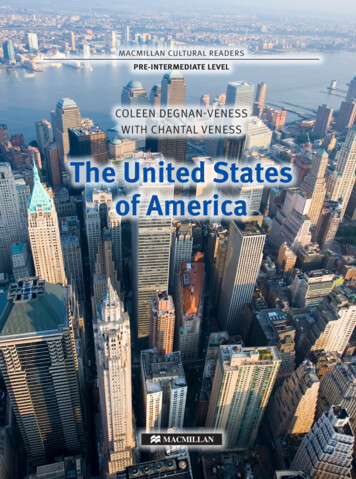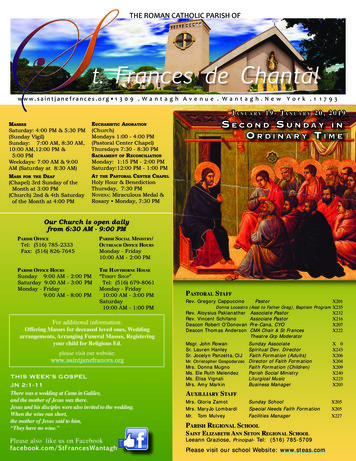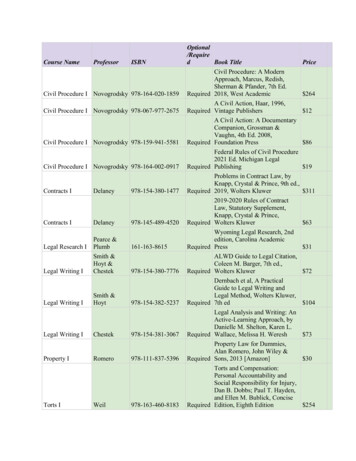
Transcription
MACMILLAN CULTURAL READERSPRE-INTERMEDIATE LEVELCOLEEN DEGNAN-VENESSWITH CHANTAL VENESSThe United Statesof AmericaMACMILLAN
1 FreedomGeorge Washington13iGeorge WashingtonBorn: February 22, 1732Westmoreland County, VirginiaDied: December 14, 1799 MountVernon, VirginiaSchools: studied at homeCareer: landowner, soldier, generaland commander-in-chief of thecolonial army, first president of theUSAOwned: Mount Vernon, oneof Virginia’s most importantplantations; more than 100 slavesIn the fifteenth century, the richestEuropean countries wanted to findnew water routes to Asia because theywanted to trade—buy or sell things—with other countries and becomericher. King Ferdinand and QueenIsabella of Spain sent explorers—menlooking for new lands and routes forships—across the oceans to find awestern route to Asia. One of thesemen was the explorer ChristopherColumbus, born in Italy, but who worked for the Spanish king and queen.He arrived in the Bahamas, islands southeast of Florida, on October 12,1492. There he met people who painted their bodies and wore animalskins. He called the native14 people “Indians” because he thought he was inIndia, and they continued to be wrongly called Indians for more than fourhundred years. Today they are called Native Americans.8
Freedom156516071609The Spanishsettle SaintAugustine(Florida).The EnglishThe Spanishsettle Jamestown settle Santa Fe(Virginia).(New Mexico).16131619The Dutch settle Slaves arrivealong thefrom Africa.Hudson River(New Amsterdam,later New York).1620The Englishsettle Plymouth(Massachusetts).iSeven years later, in 1499, another Italian explorer working for theSpanish sailed along the coast of South America. His name was AmerigoVespucci, and this is where the name “America” comes from.In 1609, an Englishman called Henry Hudson became the first explorerto sail up a river that is now the Hudson River in New York City. He workedfor a large trading company called the Dutch East India Company, and soonafter this Dutch people began to settle15 on the new continent.At the same time, Europeans also went to Africa to buy people. These peoplewere then shipped to North and South America and sold to farmers. When theAfricans arrived, they became slaves—people without freedom—who had towork for no money and do what they were told P. They had to work very hardon the coffee, tobacco16, cotton, and sugar plantations, which were very largefarms. Some worked in white people’s houses, where they cooked, cleaned, andtook care of children. More than ten million Africans were shipped to Americaover three hundred years. Families could not stay together, and so husbandslost wives and parents lost children. The slaves did not go to school, so mostof them could not read or write. Their lives were very hard. Some slaves wereowned by people who were kind, but many were not.People went to North America for different reasons. One hundredand two people left England for the new continent because they wantedreligious17 freedom. These people were known as Pilgrims and they arrivedin 1620, on a ship called The Mayflower.The place where they first arrived became a very important symbol18 inthe history of the country’s fight for freedom. The rock that they first walkedon, in Plymouth, Massachusetts, is called Plymouth Rock. Life for thePilgrims was difficult. The weather was very cold and there were dangerouswild animals. Many people died. But the Pilgrims could own land and livebetter lives than they had in Europe. At the end of the first year, the localpeople—the Native Americans—and the English settlers celebrated with alarge meal together to give thanks that they were still alive.9
1Pilgrims from The Mayflower arriving at Plymouth RockAt first, the Native Americans were happy to help the settlers. Theytaught them how to grow native plants for food and medicine, where tofind wild animals for meat, and how to use animal fur for clothes. But therelationship between the Native Americans and settlers changed whenmore and more settlers arrived and took more land. There were terriblewars between the Native Americans and the settlers.In 1624, the Dutch settled New Amsterdam on the Hudson River. Later,in 1664, King Charles of England gave orders to his men to take NewAmsterdam from the Dutch. The Dutch settlers were unhappy with theDutch government19, so they did not fight very hard when King Charles’sbrother, the Duke of York, took the settlement from them. He then changedits name to New York.10
FreedomIn the eighteenth century, there were thirteen colonieson the east coast of the continent. England, at that timethe richest and strongest country in the world, ruled thesecolonies. The thirteen colonies later became these states:Maine, Massachusetts, New Hampshire, Connecticut, NewYork, Pennsylvania, New Jersey, Maryland, Delaware, Virginia,North Carolina, South Carolina, and Georgia.By 1763, King George the Third and his British governmentexpected the colonists to help British soldiers living in thecolonies. The colonists had to give the soldiers food and a bed.This was expensive, and the colonists were very unhappy. TheBritish government also expected the colonists to pay taxes20on tea, coffee, wine, and sugar.On December 16, 1773, about one hundred colonistsdecided to show King George what they thought of his taxon tea. They went to Boston Harbor at night, where therewere three British ships full of tea. The men dressed as NativeAmericans and threw all of the tea into the water. In Americanhistory, this important event21 is known as the Boston TeaParty. King George was angry and he closed Boston Harbor.The colonists began to prepare for war against22 England.One colonist, Thomas Jefferson, wrote a very famousdocument, called the Declaration23 of Independence24. Init, he said that the colonies were a new and independentcountry. On July 4, 1776, Thomas Jefferson, John Adams and someother men signed25 the Declaration of Independence at IndependenceHall in Philadelphia, Pennsylvania. In the Declaration of Independence,Jefferson wrote, “All men are created equal26” and he wrote about man’sright27 to life, liberty (freedom), and happiness. Men on horses took thedocument to colonial towns and read it to the people. Now King Georgewas angrier than ever with the colonists, and he sent more soldiers withguns across the Atlantic Ocean to New York. General George Washingtonand his army of colonists were waiting for them. France and Spain joinedWashington and the colonists in the long American War of Independenceagainst Britain.Many people died in the American War of Independence. But in 1783,the war ended and a new country was born: the United States of America.11
1“All men are created equal.Thomas Jefferson,in the Declaration ofIndependence”iThomas JeffersonBorn: April 13, 1743 Shadwell,VirginiaDied: July 4, 1826 Monticello,VirginiaEducation28: College of William andMaryCareer: lawyer, historian, startedthe University of Virginia, thirdpresident of the USAOwned: several plantations andabout 200 slavesiBenjamin FranklinBorn: January 17, 1706 Boston,MassachusettsDied: April 17, 1790 Philadelphia,PennsylvaniaSchools: school for one year, taughtby his older brotherCareer: writer and printer ofnewspapers, inventor, wroteagainst slaveryThe people were no longer colonists; they were Americans. Some colonistswho did not want independence, and who fought with the British armyagainst their colonial neighbors, escaped to Britain or Canada.George Washington, Benjamin Franklin, and other important colonialleaders29 wrote the Constitution of the United States of America in 1787.The Constitution is the government document that said that the newgovernment was a democracy30, a government “of the people, by the people,12
FreedomThe signing of the Declaration of Independenceand for the people.” George Washington became the first president, andJohn Adams was his vice-president31.The USA grew larger by buying land from other countries and by winningland in wars. In the north, cities grew quickly, and trade and business mademany people rich. In the south, there were lots of big farms, and farmingmade many people rich there. Between 1793 and 1861, over eight hundred13
1thousand slaves were sent from the northern states to the south to work onfarms. Africans continued to be slaves for many more years. Slavery did notend until another war was fought—the American Civil War—a war betweenthe states of the north and the south. After this war ended in 1865, slaveswere free, and some African–American men worked in the government.But it took almost one hundred years before African–Americans had equalrights in the USA.Life in the USA also continued to be very bad for the Native Americans.Many died trying to protect32 their land and their families, but they werelosing the fight. In 1831, the US government had started to move NativeAmericans to reservations—pieces of land for Native Americans only—so that they could take their land. The long journey to the reservations,often in very cold weather and without food, killed many men, women, andchildren.iNative American tribesThe Iroquois Nation is a groupof six Native American tribes (theCayuga, Mohawk, Onondaga,Oneida, Seneca, and Tuscarora)that have lived together under onelaw in New York State for hundredsof years. James Fenimore Cooperwrote about these warriors inhis famous book, The Last of theMohicans. (A Mohican is a personin the Mohawk tribe.)The Lakota Sioux tribe lives inthe area that is now Minnesota,Wisconsin, North and SouthDakota, and part of Nebraska. Inthe past they had lived near theGreat Lakes further east, but asmore European settlers arrived,they had to move west. There areseven Sioux tribes in total.Sitting BullSitting Bull, a brave33 leader of the Lakota Sioux tribe34, brought manytribes together to stop the US army from taking their land in South Dakota.14
FreedomWhen General George Custer and the US army arrived at Little Big Hornon June 25, 1876, Sitting Bull was waiting with two to three thousandtribesmen. General Custer and 267 soldiers were killed that day.The US government sent thousands more soldiers. They wanted SittingBull to tell his tribes to stop fighting. Sitting Bull left and went to Canada.When he returned to the USA, he stopped fighting the US army. On December15, 1890, Sitting Bull was killed when US police officers tried to take him toprison. Two weeks later, the US army went to Wounded Knee, South Dakota,and killed one hundred fifty Lakota men, women, and children.182718611861–186518901924Slavery is againstthe law in New YorkState.Abraham Lincolnbecomes thesixteenth president.American Civil War.US army kills overone hundred fiftyLakota Sioux Indiansat Wounded Knee.Native Americansget full citizen rights.iThe USA has always been a country with a lot of immigration. After theCivil War, many Americans left their homes in the east and went to westernstates, where they could buy cheaper farmland. Another twelve millionimmigrants, many from the south and west of Europe, arrived between1892 and 1924.People wanted to live “the American Dream”, the idea that those whowork hard could find success and get rich. In 1850, there were fewer thantwenty millionaires in the USA, but by 1900, there were forty thousand! The1920s were a time of wild spending and a lot of fun for many Americans.But on October 24, 1929, everything changed when there were terriblefinancial problems and the US dollar crashed. The years that followed areknown in history as the Great Depression, which left many thousands ofpeople without money, jobs, homes, or food. By 1933, millions of people hadno work and they wanted a new president. President Franklin D. Rooseveltwas that man, and he promised to help Americans find jobs. Roosevelt spentgovernment money on programs for rebuilding the country. Americanworkers got jobs building roads, airports and schools, and by 1943, ninemillion Americans were better off P.15
were free, and some African–American men worked in the government. But it took almost one hundred years before African–Americans had equal rights in the USA. Life in the USA also continued to be very bad for the Native Americans. Many died trying to protect32 their

